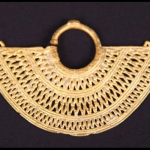The Navajo tribe of Native Americans is known for exquisite craftsmanship when it comes to handwoven textiles. As a result, many American Indian art auctions feature Navajo blankets prominently. With the many varieties of patterns and colors on the market, it is useful to know some basics for distinguishing the defining characteristics of a quality handwoven Navajo textile. This guide will help both ardent collectors and casual enthusiasts appreciate the beauty of the Navajo aesthetic. After reading, those interested in purchasing a blanket of their own can visit one of the many western art auctions listed on iCollector.com.
Classical designs
Up until the late 19th century, there were only three styles of Navajo blankets. The blankets were woven from the wool of the Spanish Churro sheep, which was introduced by Spanish settlers in the 16th century. The three styles are categorized as first phase, second phase and third phase. First phase blankets feature wide horizontal stripes in blue, white and brown. Second phase blankets are a little more complex with the addition of rectangular patterns in between the horizontal bars. The third phase blankets are the most complex, as diagonal patterns and diamond shapes are introduced.
First, second and third phase Navajo blankets are often very highly valued. During the 19th century when they were being produced, the handwoven textiles would sell for anywhere from $100 to $150 each, almost a year's wages for the average American at the time. Even today the original rugs are very expensive, some being valued as much as $500,000.
Later designs
As the Navajo tribe grew in its knowledge of weaving practices, so too did the complexity of the products. What were originally rugs meant to be worn transitioned into rugs meant to be sold. Rugs in the style known as Germantown were made from brightly colored machine-spun wool yarn. The bright colors earned them the nickname Eyedazzlers.
Other later rug styles are regional variations that are named for their places of origin. These include Crystal, Ganado, Wide Ruins, Burntwater and Two Grey Hills. Each style has its own flourishes that make it unique, but all Navajo rugs and blankets share certain features that can serve to verify a textile's appellation as a Navajo piece. These include a lack of fringe and a wool warp, as opposed to cotton or linen.
To find a Navajo blanket of your own, visit iCollector.com.



